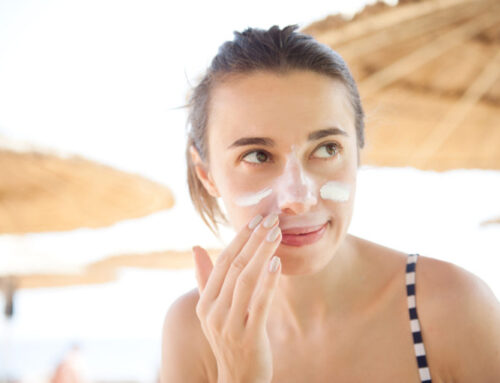
Hyperpigmentation refers to the darkening of specific areas of the skin, resulting in an uneven skin tone or the appearance of large dark patches. This phenomenon occurs when melanocytes, responsible for producing the pigment melanin, are stimulated to increase their pigment production. Factors that can trigger melanocyte stimulation include exposure to sunlight, hormonal changes, trauma, inflammation, medications, and various other factors that are continuously being discovered. Interestingly, recent findings indicate that an increase in blood vessels, known as vascularization, also contributes to melanocyte stimulation and the development of hyperpigmentation.
Hyperpigmentation is a prevalent and emotionally distressing condition, often manifesting in forms such as melasma, solar lentigines (sunspots), and post-inflammatory hyperpigmentation (PIH).

New Evidence Reveals the Causes of Hyperpigmentation
Hyperpigmentation, characterized by the darkening of specific areas of the skin, has been the subject of recent research uncovering its underlying causes. Two common forms, melasma and sunspots, typically appear on sun-exposed areas, particularly the face. On the other hand, post-inflammatory hyperpigmentation (PIH) can occur in any area of the skin affected by trauma or conditions such as acne, eczema, or insect bites.
All types of hyperpigmentation are known to worsen with sun exposure. The sun’s ultraviolet radiation has been identified as the primary contributor, with symptoms worsening during the summer and improving in winter when UV exposure is less intense.
Genetic and hormonal factors play a significant role in melasma, which is often triggered by pregnancy or the use of contraceptive pills.
While the influence of environmental factors is a recent area of examination, emerging evidence suggests additional causative factors contributing to skin aging and hyperpigmentation.
The solar energy spectrum consists of ultraviolet radiation (A, B, and C), visible light, and infrared. Visible light, which is the light we see, has longer wavelengths than ultraviolet A and B, enabling it to penetrate deeper into the skin. Although traditionally not considered harmful, recent studies have found that visible light can stimulate melanocytes to produce pigment. This effect is particularly noteworthy in individuals with darker skin, as repeated long-term exposure to visible light may lead to hyperpigmentation. Furthermore, visible light has been associated with inflammation and the production of reactive oxygen species, potentially causing DNA damage, although its role in skin cancer development has not yet been established.
Also read: How Stress Affects the Skin
It is worth noting that most conventional sunscreens do not offer adequate protection against visible light. Sunscreens containing iron oxide and antioxidants, however, can provide some defense against visible light.
Infrared radiation (IR), representing the longest wavelength of solar energy, penetrates even deeper than visible light. IR activates matrix metalloproteinase, contributing to collagen breakdown and skin aging. Moreover, infrared radiation induces inflammation and vascularization (blood vessel production), leading to hyperpigmentation. Currently, there are no effective methods to shield against infrared radiation, and only topical antioxidants have shown some protective effects.
Traffic-related air pollutants, including tropospheric ozone and polycyclic aromatic hydrocarbons, are another contributing factor. These pollutants generate free radicals that deplete the skin’s antioxidant reserve, leaving it vulnerable to DNA mutations and melanocyte stimulation.
As research continues to shed light on the causes of hyperpigmentation, it becomes increasingly important to explore effective preventive measures and protective strategies.
Effective Treatments for pigmentation
-
Topical Treatments:
1.1 Hydroquinone: Gold Standard Skin Lightening Agent
- Inhibits the enzyme tyrosinase to reduce melanin production.
- Prescribed by dermatologists in various combinations.
- Responsible use is important due to its previous misuse for general skin lightening.
1.2 Kojic Acid:
- Well-studied skin lightening agent
- Found in numerous creams and generally well tolerated.
- Neoretin Booster Serum, SkinCeuticals Metacell Renewal, NeoStrata Enlighten Pigment Gel are effective options.
1.3 Arbutin:
- Considered safe and effective.
- Inhibits tyrosinase and decreases melanin production.
- Synergistic effects when combined with substances like vitamin C, licorice, glycolic acid, and kojic acid.
-
Skincare Systems:
2.1 Obagi Nu-Derm System:
- Combines Arbutin and exfoliating ingredients to inhibit melanin production and remove pigmented cells.
- Suitable for those with sensitive skin
2.2 Obagi C Clarifying Serum:
- Contains 10% Vitamin C and Arbutin
- Protects against sunlight and environmental aggressors while inhibiting melanin production.
- Targets early aging and hyperpigmentation.
2.3 Vitamin C:
- Potent antioxidant that indirectly inhibits tyrosinase and decreases melanin production.
- Obagi Professional C Serum and SkinCeuticals CE Ferulic offer effective options.
2.4 Ellagic Acid:
- Natural phenol antioxidant that inhibits melanin transfer to skin cells
- SkinCeuticals Advanced Pigment Corrector contains ellagic acid, niacinamide, vitamins, and salicylic acid
2.5 Tranexamic Acid:
- Reduces pigmentation by affecting the plasminogen activator pathway.
- SkinCeuticals Discoloration Defense combines tranexamic acid, kojic acid, niacinamide, and HEPES for effective melanin production inhibition and removal of pigmented cells.
Choosing the appropriate treatment regimen and maintaining regular use is essential for long-lasting results, as hyperpigmentation should be managed as a chronic condition. Consultation with a dermatologist is advised to determine the most suitable treatment options for individual cases.
Also read: How Stress Affects the Skin

Managing Hyperpigmentation: A Constant Journey
Hyperpigmentation should be acknowledged as a chronic condition that requires ongoing management. Consistency is key when it comes to treatment regimens, which typically involve intense phases of prescription treatments and procedures, followed by maintenance routines.
However, no comprehensive treatment plan for hyperpigmentation can be considered complete without emphasizing the importance of strict daily sunscreen use. Sunscreen acts as a vital protective shield in preventing further skin discoloration and maintaining the effectiveness of other treatment methods.





